Miata Torsen Differential Swap
Aside from using Tochigi-Fuji in 2003, Miatas had robust Torsen limited slip differentials available from 1994 to 2005. This makes parts readily available, making a Miata torsen differential swap the quickest way to upgrade your open differential car to two-wheel burnouts. I decided to install one while I was doing my K24 swap. Note that these instructions are for a 1997, although NB Miatas should be similar.
1.6 vs 1.8
1990-1993 cars came with a smaller differential that is known to be very fragile. Plenty of these have been shattered under stock power. A Miata torsen differential swap with a 1994+ Torsen rear end is a great upgrade for these cars, and follows the same general outline as below.
One Piece vs Two Piece
Miata Torsens are sometimes called either “one piece” or “two piece”, referring to how the axles connect to the differential. The differential in the picture has “one piece” axles, because the whole axle slides into the differential. With two piece axles, the axles bolt into flanges on the differential, much like a driveshaft.
Two piece axles are easiest to work with, but if your car already has one piece, you’ll have to buy the entire rear end to switch over. I didn’t want to go through all that hassle.
Additionally, one piece axles give more clearance for exhaust. Specifically, the KMiata 3″ exhaust won’t clear two piece axles.
Gearing
If you’re putting a Torsen in, you can also change gearing at this time. For my K24 swap, a 4.10 final drive and 6-speed transmission is reported to work well, so that’s what I went with. Most 5-speed cars came with a 4.30 final drive, while the NB 6-speed cars came with 3.9, except for MazdaSpeed Miatas, which had 4.10. In general, naturally aspirated cars do better with 4.30 gearing. Turbo cars have more mid-range torque and are better suited to 3.9 or even 3.6 gears.
If you do change gearing, you’ll also probably want to swap your speed sender in the transmission to correct the speedometer reading.
Parts Required
- Torsen differential – Obviously required for a Miata torsen differential swap
- Differential bushings
(optional, but this is a great time to replace them)
- Differential seals (two for the axles, one for the driveshaft side) – I chose not to replace these as mine looked fine
- 7/8″ or 22mm O2 sensor socket
– To remove the rear O2 sensor
I’ll note that you don’t need an entire housing and rear end necessarily. I bought a Torsen out of another 97 Miata that also used one piece axles. This meant I could use my existing housing and axles, saving some money. The picture shows the bare minimum. (Setting up a new ring and pinion is outside the scope of this article.) Buying a differential in a housing will save you a little bit of time. If you want to go from one piece to two piece axles or vice-versa, you’ll need the entire rear end.
Rear Brace Removal (If necessary)
This rear chassis brace is present in certain model years, including my 1997. If your car has one, it needs to be removed before the exhaust can come out easily. There are six bolts, three on each side.
Working your way along each side of the brace, you can see the bolts. Two of them toward the rear have loose nuts on top, while the other four thread into captive nuts.
And here is the brace after removal. Again, not all cars will have this.
Rear O2 Sensor Removal
Your O2 sensor socket can be used to undo the rear O2 sensor, assuming you have one. The sensor can be tucked up into the transmission tunnel while you do the rest of the work.
Exhaust Removal
The exhaust will interfere with removing the diff, so it must be removed from the catalytic converter on back. The two bolts should be undone first, as they will hold the rear of the exhaust to the cat. They may be pretty rusty if they have never been removed. NB Miatas may be able to get away with separating the muffler only, further back in the exhaust.
My 1997’s exhaust was held on with these three exhaust hangers. They can be rather difficult to remove; I’ve found some silicone grease and pliers go a long way towards sliding them off. If yours are in bad shape, you can also simply cut them off and replace with new ones. Replacements are cheap and widely available. Earlier NA cars may have a fourth mount closer to the catalytic converter.
Once that’s all done, the exhaust comes right out as pictured.
Drain the Differential Oil
Before proceeding, you should drain the differential. Remove the fill bolt (top) first, to make sure you can refill it afterwards. Then, remove the bottom bolt (drain). Be sure to have a pan ready underneath the differential to catch the fluid.
Driveshaft Removal
The driveshaft connects to the differential with four bolts. You can spin the driveshaft by hand in neutral to access each of these and put it in gear with the parking brake to help hold it while you break them loose.
Once all four bolts are out, the driveshaft will drop down from the diff. You can pull it out of the transmission if you want it entirely out of the way, just be aware that it may leak transmission fluid. Drain the transmission if you want to avoid this, especially if you’re planning to change the transmission fluid anyway.
PPF Removal
This part can be pretty tough. Remove these rear two bolts connecting the Power Plant Frame (PPF) to the differential. The one to the right, in particular, is prone to getting stuck. If you can’t remove these two bolts, you can instead disconnect the front half of the PPF from the transmission, and deal with these two bolts with the differential out of the car.
The top of each bolt has a spline nut or nut-sert or whatever you want to call it that needs to be removed. Thread the bolt in a few turns and tap it out with a hammer.
This insert should be pried out as well. Once its removed, the ppf can be pulled off of the differential.
Here is a view of how the PPF bolts fit together inside the car, for illustrative purposes. You do not have to remove the entire PPF to do a Miata Torsen differential swap.
Loosen the Control Arms
Undo the bolt holding the upper control arm to the wheel spindle on each side. You can use a pry bar to pull them apart.
Then, loosen the long bolt through the outer part of the lower control arm. Don’t remove it all the way. The wheel hub will droop further when this is done.
Detach the Axles
Since these are one piece axles, you have to use a couple of screw drivers to pop them out. With sufficient force, the axles will suddenly pop out of the diff. If you have two piece axles, you can simply unbolt them. The flathead from Milwaukee’s demolition screwdriver set worked great for this, although you need two.
When the axles are popped out, they’ll look like this. They sit in the diff loosely.
Undoing the Differential Mounts
The differential is about ready to come out. Remove both of these 14mm retaining nuts on each side.
Ensure the differential has a floor jack under it.
Finally, remove the larger 17mm nut from each side. An impact wrench is helpful.
Removing the Differential
The one piece axles interfere with removal of the diff. I had to shift the diff one way fairly far, as shown, to have enough clearance to pull the other axle out. Then I was able to move it back the other way and repeat.
After a bit of finagling, the differential housing is out.
Removing Differential from Housing (If Necessary)
As stated, I bought a differential without a housing because it was cheaper. This means I had to swap the new diff into my old housing, however. To remove the differential from the housing, undo all of the bolts on the cover as pictured.
Here are the myriad bolts you’ll have afterwards. It is fairly obvious where the longer bolts go from looking at the housing.
With all the bolts out, a firm smack on the top of the housing with a dead blow hammer should be enough to separate the differential.
Here are the two differentials side by side.
Here’s a shot showing how to easily distinguish an open differential from a torsen. The open differential has this bar visible, while you can see straight through the Torsen.
You can clean the housing with some brake cleaner. Most importantly, be sure to get the mating flanges for the housing and the differential clean and free of old RTV. Lay down a bead of RTV on the housing, and slide the Torsen into place. Be careful to line it up so it goes straight in without smearing the RTV. I prefer Permatex Ultra Black
RTV for almost everything, as it’s the one formula that never leaks on me.
Finally, torque the differential bolts back down incrementally in a star pattern. They torque to 19 lb-ft. So torque them all to 5, 10, and then 19 or similar.
Removing the Old Differential Bushings (Optional)
If you’re installing new differential bushings like me, you have to remove the old ones. I started by drilling a bunch of holes until the center fell out.
Once that was done, I used my Milwaukee demolition screwdriver and 4lb Estwing mini sledge
to bend in the lip at the bottom of the old bushing. The key is a heavy hammer and a screwdriver with a steel end cap.
I did that until it looked like this. Then, I began hammering the screwdriver into the bushing from the top, to force it out.
This procedure mangled the old bushings but left the bores in good shape.
You should clean out the bores before installing new bushings. A wire wheel on a drill makes quick work of this.
Installing the New Bushings (Optional)
I went with Energy Suspension polyurethane bushings as pictured.
Grease up the bushing thoroughly with the included grease. It should slide right in with hand pressure. You can use a clamp or vise if necessary.
The inner bearing goes next, again lubricating it before installation.
Some 6″ C-clamps and a larger socket made short work of pushing the sleeves flush into the bushing. The top should be flush, while the bottom protudes a bit. This portion on the bottom fits into the bottom half of the bushing later on.
Preparing the Retainer Plates (Optional)
If you’re using Energy Suspension differential bushings, among others, you reuse the Mazda retainer plates. However, you need to get rid of the rubber on them. The easy method is to simply light them on fire. Do this at your own risk, as the fumes are almost certainly toxic. Once they’re sufficiently torched, the rubber peels right off of the steel.
Once all the rubber is off, you can clean off any remaining residue with a wire wheel and light hand sanding. I then hit mine with some spray paint to keep it from rusting.
Axle Seals (Optional)
You may choose to replace your seals at this time. There are three, one for each axle and one on the front behind the driveshaft flange. My axle seals were in good shape, as pictured, so I elected to leave them alone.
Reinstallation
As the Haynes manual says, reinstallation is the reverse of removal. I used a floor jack to lift the differential back into place, again using the left-right shimmy to coerce the axles back into the diff. Then, I jacked the differential completely into place and installed the bottom half of the bushing and retainer plates as shown. The large diff bushing nuts torque to about 70 lb-ft, and the smaller 14mm nuts are 14-20 lb-ft.
You’ll probably notice a gap between the diff and the axles at this point, if you have one piece axles. They need to be seated in the diff.
Push the axles in as far as you can by hand. When you’re reasonably sure they’re centered, a firm tap on the axle nut with a block of wood should seat them. They will pop when they’ve gone back in place.
After seating, the axle will be much closer to the diff. And that about wraps it up, Miata Torsen differential swap complete. Reinstall the driveshaft and power plant frame and don’t forget to add lubricant. Depending on how fresh the Torsen is, you may want to do a short interval oil change.


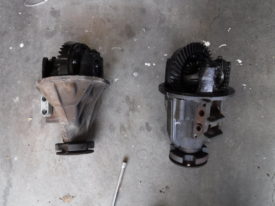
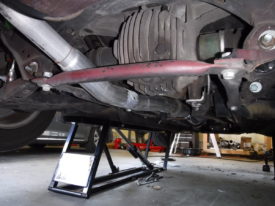
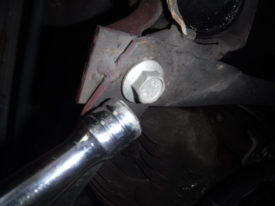
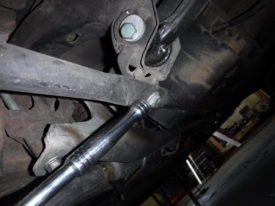
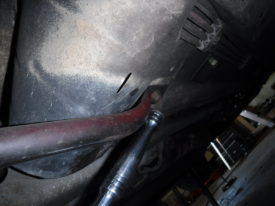
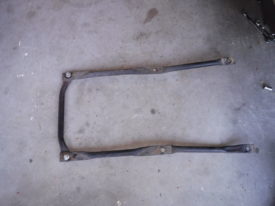
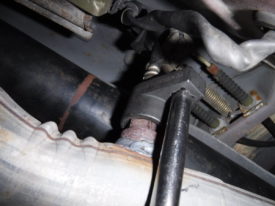
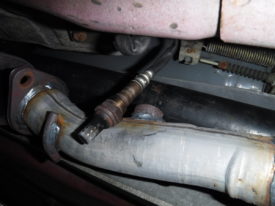

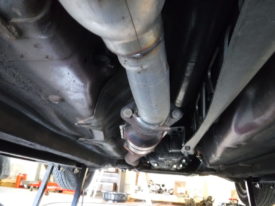
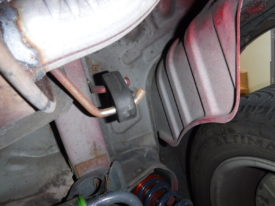

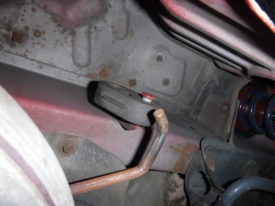
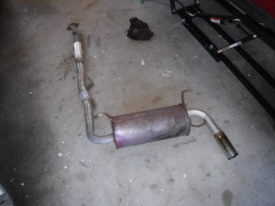
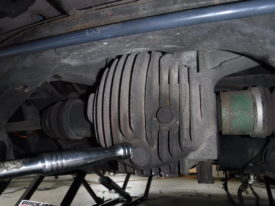
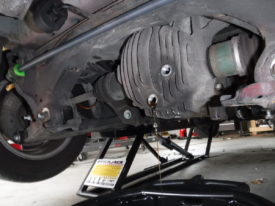
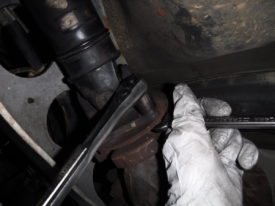
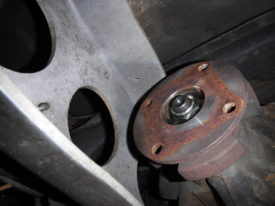
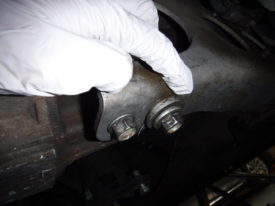
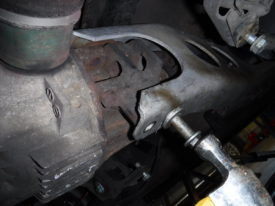
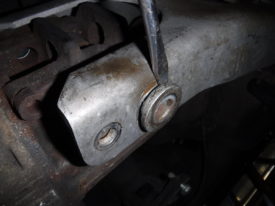
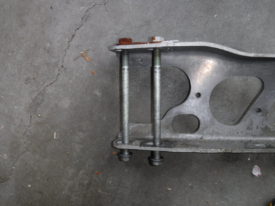
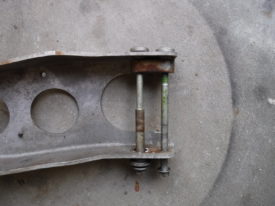
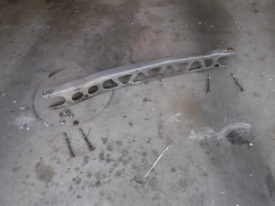
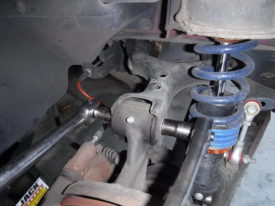
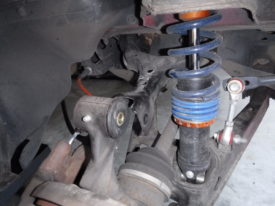
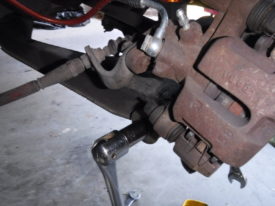
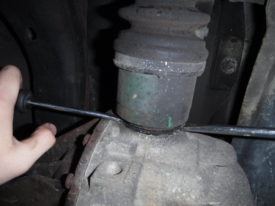
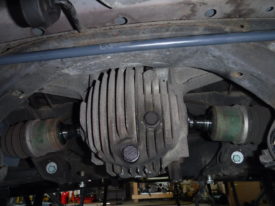
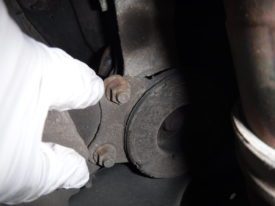
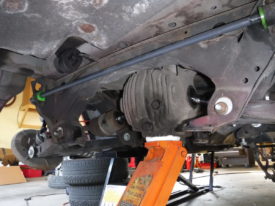
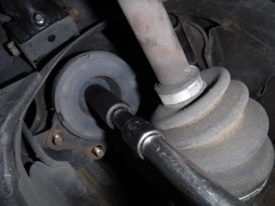



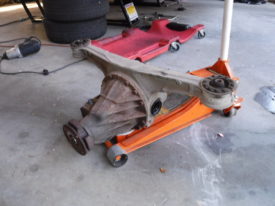
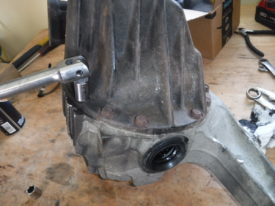
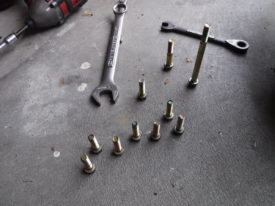
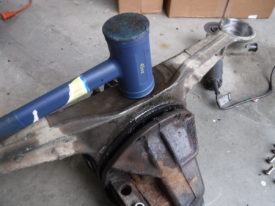
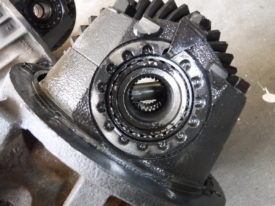
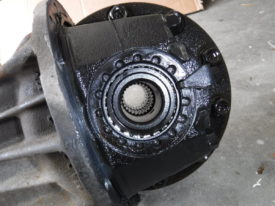
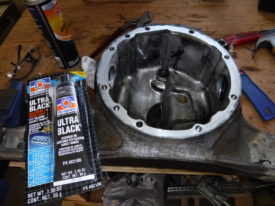
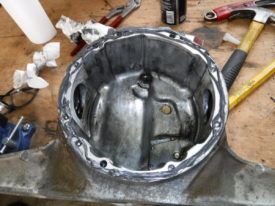

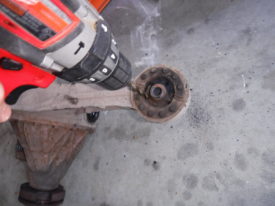
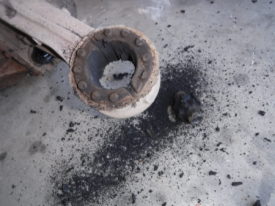
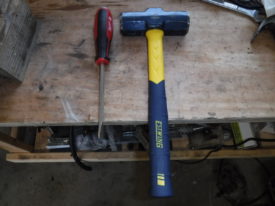
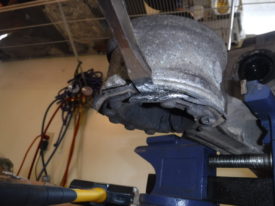
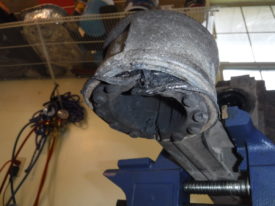
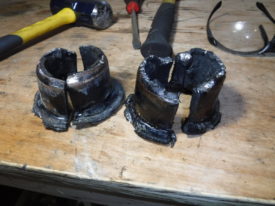
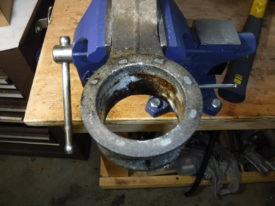
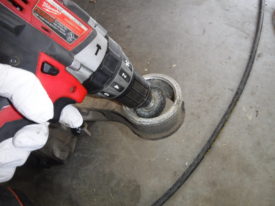
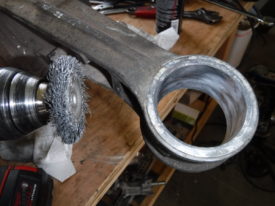
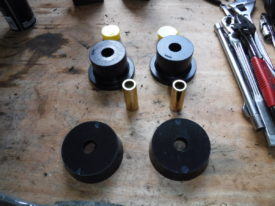
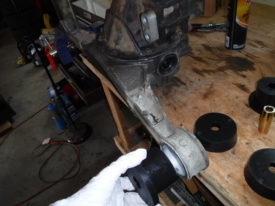
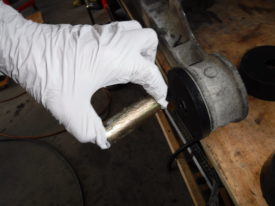
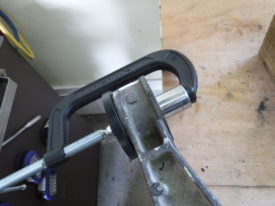
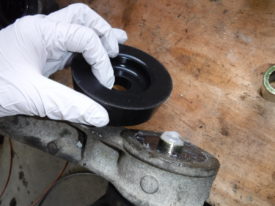
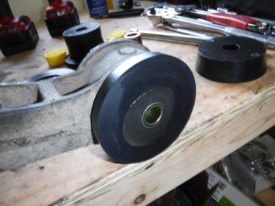
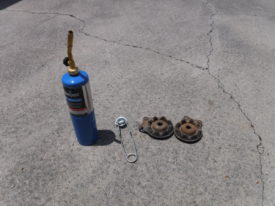
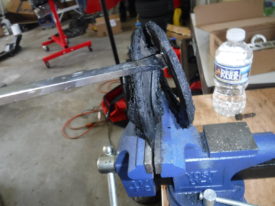
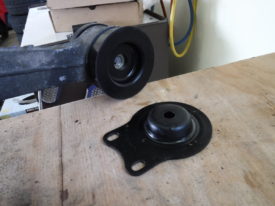
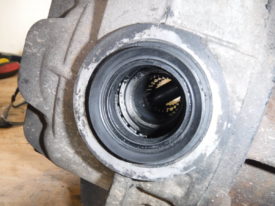

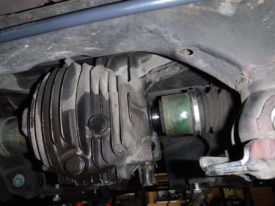
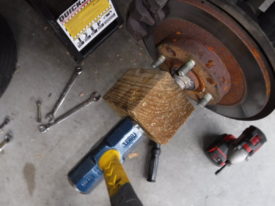
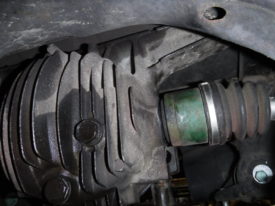
Why didn’t you also reinforce the differential arms (welding a plate to it) while it’s out? I’ve heard the arm can break off.
Wasn’t sure if it was necessary, but I’m considering going back and doing it.
Were you able to bolt the old driveshaft to the torsen diff? I’ve seen people say you need a driveshaft from a newer model since the differential is longer than the original.
you do need a new driveshaft. he has a 1997 miata, so his driveshaft is compatible.